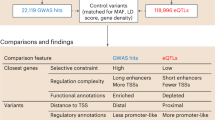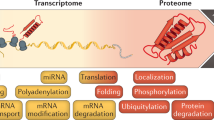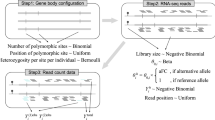Abstract
Treating messenger RNA transcript abundances as quantitative traits and mapping gene expression quantitative trait loci for these traits has been pursued in gene-specific ways. Transcript abundances often serve as a surrogate for classical quantitative traits in that the levels of expression are significantly correlated with the classical traits across members of a segregating population. The correlation structure between transcript abundances and classical traits has been used to identify susceptibility loci for complex diseases such as diabetes1 and allergic asthma2. One study recently completed the first comprehensive dissection of transcriptional regulation in budding yeast3, giving a detailed glimpse of a genome-wide survey of the genetics of gene expression. Unlike classical quantitative traits, which often represent gross clinical measurements that may be far removed from the biological processes giving rise to them, the genetic linkages associated with transcript abundance affords a closer look at cellular biochemical processes. Here we describe comprehensive genetic screens of mouse, plant and human transcriptomes by considering gene expression values as quantitative traits. We identify a gene expression pattern strongly associated with obesity in a murine cross, and observe two distinct obesity subtypes. Furthermore, we find that these obesity subtypes are under the control of different loci.
This is a preview of subscription content, access via your institution
Access options
Subscribe to this journal
Receive 51 print issues and online access
$199.00 per year
only $3.90 per issue
Buy this article
- Purchase on Springer Link
- Instant access to full article PDF
Prices may be subject to local taxes which are calculated during checkout




Similar content being viewed by others
References
Eaves, I. A. et al. Combining mouse congenic strains and microarray gene expression analyses to study a complex trait: the NOD model of type 1 diabetes. Genome Res. 12, 232–243 (2002)
Karp, C. L. et al. Identification of complement factor 5 as a susceptibility locus for experimental allergic asthma. Nature Immunol. 1, 221–226 (2000)
Brem, R. B., Yvert, G., Clinton, R. & Kruglyak, L. Genetic dissection of transcriptional regulation in budding yeast. Science 296, 752–755 (2002)
Claudio, L., Lee, T., Wolff, M. S. & Wetmur, J. G. A murine model of genetic susceptibility to lead bioaccumulation. Fundam. Appl. Toxicol. 35, 84–90 (1997)
Huang, Y. H., Chen, Y. T., Lai, J. J., Yang, S. T. & Yang, U. C. PALS db: Putative Alternative Splicing database. Nucleic Acids Res. 30, 186–190 (2002)
Yan, L., Otterness, D. M., Kozak, C. A. & Weinshilboum, R. M. Mouse nicotinamide N-methyltransferase gene: molecular cloning, structural characterization, and chromosomal localization. DNA Cell Biol. 17, 659–667 (1998)
Hughes, T. R. et al. Expression profiling using microarrays fabricated by an ink-jet oligonucleotide synthesizer. Nature Biotechnol. 19, 342–347 (2001)
Drake, T. A. et al. Genetic loci determining bone density in mice with diet-induced atherosclerosis. Physiol. Genomics 5, 205–215 (2001)
Timm, D. E., Baker, L. J., Mueller, H., Zidek, L. & Novotny, M. V. Structural basis of pheromone binding to mouse major urinary protein (MUP-I). Protein Sci. 10, 997–1004 (2001)
Metcalf, D. et al. Gigantism in mice lacking suppressor of cytokine signalling-2. Nature 405, 1069–1073 (2000)
Swift, L. L., Valyi-Nagy, K., Rowland, C. & Harris, C. Assembly of very low density lipoproteins in mouse liver: evidence of heterogeneity of particle density in the Golgi apparatus. J. Lipid Res. 42, 218–224 (2001)
Borecki, I. G., Rice, T., Perusse, L., Bouchard, C. & Rao, D. C. An exploratory investigation of genetic linkage with body composition and fatness phenotypes: the Quebec Family Study. Obesity Res. 2, 213–219 (1994)
Lembertas, A. V. et al. Identification of an obesity quantitative trait locus on mouse chromosome 2 and evidence of linkage to body fat and insulin on the human homologous region 20q. J. Clin. Invest. 100, 1240–1247 (1997)
Damerval, C., Maurice, A., Josse, J. M. & de Vienne, D. Quantitative trait loci underlying gene product variation: a novel perspective for analyzing regulation of genome expression. Genetics 137, 289–301 (1994)
Causse, M. et al. Genetic dissection of the relationship between carbon metabolism and early growth in maize, with emphasis on key-enzyme loci. Mol. Breed. 1, 259–272 (1995)
Byrne, P. F. et al. Quantitative trait loci and metabolic pathways: genetic control of the concentration of maysin, a corn earworm resistance factor, in maize silks. Proc. Natl Acad. Sci. USA 93, 8820–8825 (1996)
Dausset, J. et al. Centre d'Etude du Polymorphisme Humain (CEPH): collaborative genetic mapping of the human genome. Genomics 6, 575–577 (1990)
van't Veer, L. J. et al. Gene expression profiling predicts clinical outcome of breast cancer. Nature 415, 530–536 (2002)
Tosatio, G. Generation of Epstein-Barr Virus (EBV)-immortalized B cell lines. Curr. Protoc. Immunol. 1, 7.22.1–7.22.3 (1991)
Troyer, A. F. Background of US hybrid corn. Crop Sci. 39, 601–626 (1999)
Hughes, T. R. et al. Functional discovery via a compendium of expression profiles. Cell 102, 109–126 (2000)
Amos, C. I. Robust variance-components approach for assessing genetic linkage in pedigrees. Am. J. Hum. Genet. 54, 535–543 (1994)
Lincoln, S. E., Daly, M. J. & Lander, E. S. MAPMAKER/QTL User's Manual (Whitehead Institute for Biomedical Research, Cambridge, Massachusetts, 1993)
Basten, C. A., Weir, B. S. & Zeng, Z. B. QTL Cartographer User's Manual (Department of Statistics, North Carolina State University, Raleigh, 1999)
Fisch, R. D., Ragot, M. & Gay, G. A generalization of the mixture model in the mapping of quantitative trait loci for progeny from a biparental cross of inbred lines. Genetics 143, 571–577 (1996)
Acknowledgements
Rosetta Inpharmatics is a wholly owned subsidiary of Merck & Co., Inc.
Author information
Authors and Affiliations
Corresponding authors
Ethics declarations
Competing interests
Stephen Friend is a Senior Vice President of Merck Research Laboratories.
Supplementary information
Rights and permissions
About this article
Cite this article
Schadt, E., Monks, S., Drake, T. et al. Genetics of gene expression surveyed in maize, mouse and man. Nature 422, 297–302 (2003). https://doi.org/10.1038/nature01434
Received:
Accepted:
Issue Date:
DOI: https://doi.org/10.1038/nature01434
This article is cited by
-
Diallel panel reveals a significant impact of low-frequency genetic variants on gene expression variation in yeast
Molecular Systems Biology (2024)
-
Genome-wide identification of RNA modification-related single nucleotide polymorphisms associated with rheumatoid arthritis
BMC Genomics (2023)
-
Characterization of novel loci controlling seed oil content in Brassica napus by marker metabolite-based multi-omics analysis
Genome Biology (2023)
-
Molecular quantitative trait loci
Nature Reviews Methods Primers (2023)
-
Dosage effect of anthocyanin biosynthesis in purple-grained wheat (Triticum aestivum L.)
Euphytica (2023)
Comments
By submitting a comment you agree to abide by our Terms and Community Guidelines. If you find something abusive or that does not comply with our terms or guidelines please flag it as inappropriate.



